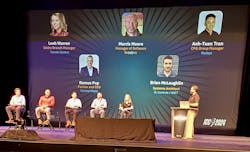4 Automation Trends Impacting Manufacturing
If you separately ask 10 industrial automation experts what the hottest trends of the moment are, you’ll likely get 10 different answers depending on the technologies they work with and in which industry area they tend to concentrate. But at the Inductive Automation Ignition Community Conference 2024, a panel of five system integrators pointed out the key industry trends they see playing out across the board of technologies and industry verticals.
The panelists were: Brian McLaughlin with SL Controls, Morris Moore with Industrial Networking Solutions, Remus Pop with Concept Reply, Anh-Tuan Tran with Rovisys and Leah Warren with Tamaki Control.
While the discussion during this panel session covered several topics, significant automation trends stood out in four areas: artificial intelligence, system and device connectivity and related data modeling, cybersecurity and edge/cloud computing.
Artificial intelligence
The use of artificial intelligence (AI) for predictive maintenance applications continues to be a top AI application in industry. Warren noted that fusing sensor data with AI is an increasingly common project with many of the manufacturers Tamaki Controls works with.
“In the consumer packaged goods industry, especially, the application of AI has become popular,” said Tran. “So now we [Rovisys] conduct ‘centerlining’ to achieve golden batch production by capturing the right data. The use of AI here is huge to predict the quality of a product, so much so that we’re often implementing this capability even before OEE (overall equipment effectiveness).”
Pop added that, at Concept Reply, “we all have a ChatGPT Pro license for answering emails and doing code scripts.” He noted that it remains important for LLM (large language model) users to check the work done by the LLM. But even with this added task, he said the use of ChatGPT still rapidly accelerates the time it takes to do the job.
Read more about how Inductive Automation encourage experimentation with ChatGPT.
The use of AI in machine vision applications was another application referenced by Pop for its increasing use to deal with lighting changes in production areas.
Connectivity and data
While COVID demonstrated industry’s need for remote data access capabilities, Moore noted one of the most challenging points that remains here is how to model data for storage and analysis in the cloud. “We’ve got the connectivity now with communication methods such as MQTT, but data modeling remains an issue,” he said.
Warren added that, 10 years ago, the big issue was on how to get data from systems most effectively. Now the issue is how to manage the data to make informed business decisions. She noted this is where UNS (unified namespace) comes into play.
Moore concurred that applications of UNS are significant with many of the projects Industrial Networking Solutions is working on that involve multiple systems consuming data using MQTT’s publish-subscribe model.
Cybersecurity
While cybersecurity has long been on manufacturers’ radar, many haven’t consider it a top operations priority until relatively recently. The big driver behind this change has come via the increasing connection of OT (operations technology) with IT as an important requirement for businesses to stay viable in the modern, connected manufacturing landscape.
“Don’t ignore cybersecurity,” cautioned Warren. “You don’t want to be the reason ransomware gets in.” She advised conducting an NIST audit at your facility as an important first step.
Get insights on NIST’s updated cybersecurity framework.
Pop added that it’s important for manufacturers to “focus on IT professionals, such as data scientists and those who are very familiar with cloud technologies, to help you scale OT applications while maintaining security as industry moves increasingly towards the cloud environment.”
Edge to cloud
When it comes to the architecture of a manufacturer’s hybrid edge/cloud environment, the panelists agreed that this is where IT/OT convergence often comes to the forefront. From issues such as who owns what data to where it should reside and be managed, edge and cloud technologies present a number of IT/OT concerns.
“Integrators often find themselves in the middle of IT/OT,” when it comes to edge/cloud projects, said Moore. “While we tend to focus on applying on-premises models, IT often wants to look at cloud services and containerization.”
Looking back on edge and cloud projects he’s been involved with, Moore said a mistake often made by integrators here is not working well with IT from the start of the project. To do this effectively, he says it’s important for integrators and OT professionals to understand when it’s best to use a cloud service.
See more about IT’s growing influence on OT.
Tran noted that, whenever you’re looking to implement edge technology, be sure that the edge devices you’re considering are robust enough for use in the plant. “These devices need to have been tested in a manufacturing environment,” he said, adding that manufacturers should be sure to look for edge products from providers with industrial experience.
Find out where edge computing benefits manufacturers most.
Declining importance
While the panel largely focused on the key technology trends having the biggest impact on manufacturing today, the discussion also touched on technologies that have been popular in the past but now seem to be losing their appeal.
Three areas cited were:
- Virtual reality. Warren noted that application of this technology is “not realistic for some industries.”
- Windows. Microsoft Windows has long been the industry standard for most industrial software applications, but McLaughlin said he is seeing less of a focus from manufacturers today on Windows-based systems
- Brand preference. The openness of modern manufacturing technologies coupled with industry’s long-held goal of avoiding vendor lock-in seems to be prevailing. Pop noted that he is encountering an increasing number of manufacturers who are “more willing to accept non-recognized brands.”
About the Author
David Greenfield, editor in chief
Editor in Chief

Leaders relevant to this article:

